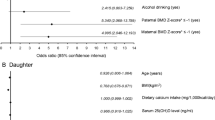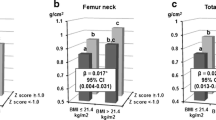Abstract
This study aimed to clarify the relationship between skeletal or lifestyle factors among Japanese daughter-mother, mother-grandmother and daughter-grandmother pairs. We performed a cross-sectional study in a cohort of Japanese adolescent daughters (12–18 years of age), their mothers (339 pairs) and grandmothers on their mothers’ side (34 pairs). Gestational age, birth weight, age at menarche and presence of menarche or menopause were surveyed in the participants. Height, body weight and lumbar 2–4 bone mineral density (BMD) were measured. Dietary intake and current physical activity were assessed by using questionnaires. Gestational age and age at menarche were significantly correlated among daughters, mothers and grandmothers (P < 0.001). BMD was significantly correlated between daughters and mothers (P < 0.001), while it was not significantly correlated between daughters and grandmothers or between mothers and grandmothers. Dietary intake of calcium and vitamin D, and the frequency, duration and intensity of current physical activity were significantly correlated between daughters and mothers (P < 0.05), although no significant correlation was found between daughters and grandmothers, or between mothers and grandmothers. The parameters for exercise indicated a positive correlation for BMD in the daughters and the mothers, but not in the grandmothers. The results suggested that estrogen deficiency decreases familial correlation for BMD after menopause. Achieving high BMD through exercise may be important for prevention of postmenopausal osteoporosis in premenopausal low-height mothers.

Similar content being viewed by others

References
NIH Consensus Development Panel on Osteoporosis Prevention, Diagnosis, Therapy (2001) Osteoporosis prevention, diagnosis, and therapy. JAMA 285:785–795
Center JR, Nguyen TV, Schneider D, Sambrook PN, Eisman JA (1999) Mortality after all major types of osteoporotic fracture in men and women: an observational study. Lancet 353:878–882
Kanis JA, Pitt FA (1992) Epidemiology of osteoporosis. Bone 13:S7–S15
Oleksik A, Lips P, Dawson A, Minshall ME, Shen W, Cooper C, Kanis J (2000) Health-related quality of life in postmenopausal women with low BMD with or without prevalent vertebral fractures. J Bone Miner Res 15:1384–1392
Silverman SL, Minshall ME, Shen W, Harper KD, Xie S (2001) The relationship of health-related quality of life to prevalent and incident vertebral fractures in postmenopausal women with osteoporosis: results from the Multiple Outcomes of Raloxifene Evaluation Study. Arthritis Rheum 44:2611–2619
Bonjour JP, Theintz G, Buchs B, Slosman D, Rizzoli R (1991) Critical years and stages of puberty for spinal and femoral bone mass accumulation during adolescence. J Clin Endocrinol Metab 73:555–563
Hansen MA, Overgaard K, Riis BJ, Christiansen C (1991) Role of peak bone mass and bone loss in postmenopausal osteoporosis: 12 year study. BMJ 303:961–964
Harris M, Nguyen TV, Howard GM, Kelly PJ, Eisman JA (1998) Genetic and environmental correlations between bone formation and bone mineral density: a twin study. Bone 22:141–145
Seeman E, Hopper JL, Young NR, Formica C, Goss P, Tsalamandris C (1996) Do genetic factors explain associations between muscle strength, lean mass, and bone density? A twin study. Am J Physiol 270:E320–E327
Arden NK, Spector TD (1997) Genetic influences on muscle strength, lean body mass, and bone mineral density: a twin study. J Bone Miner Res 12:2076–2081
Runyan SM, Stadler DD, Bainbridge CN, Miller SC, Moyer-Mileur LJ (2003) Familial resemblance of bone mineralization, calcium intake, and physical activity in early-adolescent daughters, their mothers, and maternal grandmothers. J Am Diet Assoc 103:1320–1325
Lutz J, Tesar R (1990) Mother-daughter pairs: spinal and femoral bone densities and dietary intakes. Am J Clin Nutr 52:872–877
McKay HA, Bailey DA, Wilkinson AA, Houston CS (1994) Familial comparison of bone mineral density at the proximal femur and lumbar spine. Bone Miner 24:95–107
Kuroda T, Onoe Y, Miyabara Y, Yoshikata R, Orito S, Ishitani K, Okano H, Ohta H (2009) Influence of maternal genetic and lifestyle factors on bone mineral density in adolescent daughters: a cohort study in 387 Japanese daughter-mother pairs. J Bone Miner Metab 27:379–385
Sasaki S, Ushio F, Amano K, Morihara M, Todoriki O, Uehara Y, Toyooka E (2000) Serum biomarker-based validation of a self-administered diet history questionnaire for Japanese subjects. J Nutr Sci Vitaminol 46:285–296
Sasaki S, Yanagibori R, Amano K (1998) Self-administered diet history questionnaire developed for health education: a relative validation of the test-version by comparison with 3-day diet record in women. J Epidemiol 8:203–215
Science and Technology Agency (2000) Standard tables of food composition in Japan, 5th edn. Printing Bureau, Ministry of Finance, Tokyo (in Japanese)
Orimo H, Sugioka H, Fukunaga M, Mutoh Y, Hotokebuchi T, Gorai I, Nakamura T, Kushida K, Tanaka H, Ikai T, Ohashi Y, Osteoporosis Diagnostic Criteria Review Committee: Japanese Society for Bone, Mineral Research (1997) Diagnostic criteria for primary osteoporosis: year 1996 revision. Nihon Kotsutaisya Gakkai Zasshi 14:219–233 (in Japanese)
Nguyen T, Sambrook P, Kelly P, Jones G, Lord S, Freund J, Eisman J (1993) Prediction of osteoporotic fractures by postural instability and bone density. BMJ 307:1111–1115
Ondrak KS, Morgan DW (2007) Physical activity, calcium intake and bone health in children and adolescents. Sports Med 37:587–600
Freedson PS, Evenson S (1991) Familial aggregation in physical activity. Res Q Exerc Sport 62:384–389
Perusse L, Leblanc C, Bouchard C (1988) Familial resemblance in lifestyle components:results from the Canada Fitness Survey. Can J Public Health 79:201–205
Riggs BL, Khosla S, Melton LJ 3rd (2002) Sex steroids and the construction and conservation of the adult skeleton. Endocr Rev 23:279–302
Lloyd T, Rollings N, Andon MB, Demers LM, Eggli DF, Kieselhorst K, Kulin H, Landis JR, Martel JK, Orr G (1992) Determinants of bone density in young women. I. Relationships among pubertal development, total body bone mass, and total body bone density in premenarchal females. J Clin Endocrinol Metab 75:383–387
MacKelvie KJ, Khan KM, McKay HA (2002) Is there a critical period for bone response to weight-bearing exercise in children and adolescents? A systematic review. Br J Sports Med 36:250–257
Magarey AM, Boulton TJ, Chatterton BE, Schultz C, Nordin BE (1999) Familial and environmental influences on bone growth from 11–17 years. Acta Paediatr 88:1204–1210
Ulrich CM, Georgiou CC, Snow-Harter CM, Gillis DE (1996) Bone mineral density in mother-daughter pairs: relations to lifetime exercise, lifetime milk consumption, and calcium supplements. Am J Clin Nutr 63:72–79
Going S, Lohman T, Houtkooper L, Metcalfe L, Flint-Wagner H, Blew R, Stanford V, Cussler E, Martin J, Teixeira P, Harris M, Milliken L, Figueroa-Galvez A, Weber J (2003) Effects of exercise on bone mineral density in calcium-replete postmenopausal women with and without hormone replacement therapy. Osteoporos Int 14:637–643
Kohrt WM, Snead DB, Slatopolsky E, Birge SJ Jr (1995) Additive effects of weight-bearing exercise and estrogen on bone mineral density in older women. J Bone Miner Res 10:1303–1311
Suuriniemi M, Suominen H, Mahonen A, Alen M, Cheng S (2007) Estrogen receptor alpha polymorphism modifies the association between childhood exercise and bone mass: follow-up study. Pediatr Exerc Sci 19:444–458
Acknowledgments
This work was partly supported by a grant-in-aid from the Japan Osteoporosis Foundation.
Author information
Authors and Affiliations
Corresponding author
About this article
Cite this article
Ohta, H., Kuroda, T., Onoe, Y. et al. Familial correlation of bone mineral density, birth data and lifestyle factors among adolescent daughters, mothers and grandmothers. J Bone Miner Metab 28, 690–695 (2010). https://doi.org/10.1007/s00774-010-0180-5
Received:
Accepted:
Published:
Issue Date:
DOI: https://doi.org/10.1007/s00774-010-0180-5



